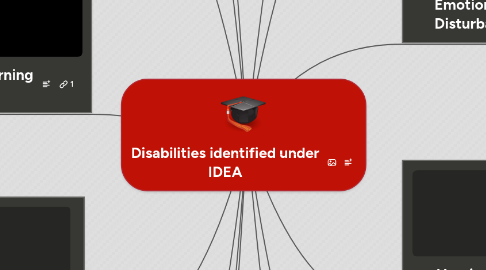
1. Autism
1.1. Accommodations
1.1.1. Visual and written daily schedules and instructions
1.1.2. Classroom aides
1.1.3. Allow extra time to respond to directions
1.1.4. Repeat or rephrase instructions
1.1.5. Posting rules of the class
1.1.6. Visual and verbal cues
1.2. Assistive technology
1.2.1. MyVoice
1.2.2. GoTalk Pocket
2. Deaf Blindness
2.1. accommodations
2.1.1. tactile interpreter
2.1.2. notetaker
2.2. Assistive technology
2.2.1. Computer Assisted Real-Time Translation (CART)- displayed in large print or fed through a refreshable braille
3. Deafness
3.1. Accommodations
3.1.1. An oral interpreter
3.1.2. captions for any videos used in class
3.1.3. Note taking
3.2. Assistive technology
3.2.1. FM system-Auditory information is connected directly to the hearing aid
3.2.2. Computer Assisted Real-Time Translation (CART)
4. Developmental Delay
4.1. Accommodations
4.1.1. visual cues to orient student in the classroom
4.1.2. Post a clear and predictable daily schedule
4.1.3. Use strategies to make directions and learning expectations clearly understood
4.2. Assistive technology
4.2.1. My Li’l Reminder
4.2.2. Brother PT1290
4.2.3. Radio Shack Talking Watch
4.2.4. Geemarc Amplified Telephone
4.2.5. B.A. Bar
4.2.6. First Then Visual Schedule
4.2.7. Mem-X
4.2.8. The Planning and Execution Trainer (PEAT)
5. Emotional Disturbance
5.1. Accommodations
5.1.1. Extend the amount of time that a student is given to complete a particular task
5.1.2. Break down assignments into smaller ones
5.1.3. Reduce the number of practice items
5.1.4. Plan short review lessons or readiness activities
5.2. Assistive technology
5.2.1. The Motivaider
5.2.2. The Talklight
5.2.3. iPod
5.2.4. BrainPop
5.2.5. Funmath.com
5.2.6. Inspiration
6. Hearing Impairment
6.1. Accommodations
6.1.1. facial expression
6.1.2. directly face the student: 3-5ft
6.1.3. Rephrase the message conveyed
6.1.4. copy of notes are provided
6.1.5. written test instead of oral test
6.2. Assistive technology
6.2.1. Hearing aids
6.2.2. Cochlear implants
6.2.3. FM system
6.2.4. Sound field system
7. Intellectual Disability
7.1. Accommodations
7.1.1. Quiet Work Space
7.1.2. functional day-to-day activities
7.1.3. Repetition of Concepts Over the Day
7.1.4. Hands on Learning
7.2. Assistive technology
7.2.1. Audiobooks, e-Text support for reading and listening comprehension
7.2.2. smartboards
7.2.3. Personal digital assistants
7.2.4. Graphic organizers
7.2.5. Screen magnifiers
8. Multiple Disabilities
8.1. Accommodations
8.1.1. Moving the student in front of the class
8.1.2. Change the way the material is presented
8.2. Assistive technology
8.2.1. IntelliTools
8.2.2. IntelliKeys
8.2.3. Clicker5
8.2.4. Smartboards
9. Other Health Impairment
9.1. Accommodations
9.1.1. Notetakers and notetaking services
9.1.2. Audio or video taped class sessions.
9.1.3. Flexible attendance requirements.
9.1.4. Extended exam time or alternative testing arrangements.
9.1.5. Assignments available in electronic format.
9.1.6. An environment which minimizes fatigue and injury.
9.1.7. For more complex activities, simplify steps to make them more manageable
9.2. Assistive technology
9.2.1. personal digital assistants
9.2.2. dictating machines
9.2.3. computer programs
10. Specific Learning Disability
10.1. Accommodations
10.1.1. “read-along” technique with taped texts and materials
10.1.2. Tape the lesson or the teacher should provide a copy of the lesson outline.
10.1.3. educational videos and films or talking books
10.1.4. word webs and visual organizers
10.2. Assistive technology
10.2.1. computers with print-recognition software that "read" text aloud
10.2.2. speech recognition systems that turn oral language into written text
10.2.3. talking calculators that assist people with math difficulties
10.2.4. software that predicts and edits words for people who are prone to spelling difficulties
11. Speech or language impairment
11.1. Accommodations
11.1.1. giving additional time to complete assignments
11.1.2. substituting written papers or projects for oral presentations
11.1.3. allowing the student to demonstrate learning one-on-one with the teacher
11.2. Assistive technology
11.2.1. augmentative and alternative communication device
11.2.2. speech output device
12. Traumatic Brain injury
12.1. Accommodations
12.1.1. Preferential seating to optimize attention and concentration
12.1.2. Avoiding distracting stimuli
12.1.3. Subtly repeating directions to the student after they have been given to the class
12.1.4. Using computer-assisted instruction
12.1.5. Providing visual aids, large print
12.1.6. Breaking longer presentations into shorter segments
12.2. Assistive technology
12.2.1. Highlighting pen/tape
12.2.2. Slant board
12.2.3. Tape recorder with head phones
12.2.4. Calculator with large print display and/or large keypad
12.2.5. Portable word processor with built-in spellchecker
12.2.6. Electronic dictionary/thesaurus
13. Visual impairment including blindness
13.1. Accommodations
13.1.1. Braille
13.1.2. Large print
13.1.3. Lesson will be given in accesible format before the class starts
13.2. Assistive technology
13.2.1. Audio
13.2.2. Video Magnifiers (CCTVs)-access to diagrams, graphs, maps, math
14. Orthopedic Impairment
14.1. Accommodations
14.1.1. Special seating arrangements to develop useful posture and movements
14.1.2. Instruction focused on development of gross and fine motor skills
14.1.3. Securing suitable augmentative communication and other assistive devices
14.2. Assistive technology
14.2.1. speech recognition software
14.2.2. screen reading software
14.2.3. augmentative and alternative communication devices
14.2.4. academic software packages for students with disabilities
